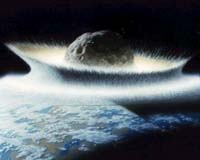Global Wildfires Did Not Kill The Dinosaurs
 New NERC funded research, shows that although forest fires played an important part in the latest Cretaceous and earliest Tertiary ecosystems, there is no evidence that North America was engulfed by wildfires 65 million years ago. |
New research has revealed that thermal radiation, resulting from the impact of an asteroid colliding with the United States 65 million years ago, was not responsible for the extinction of dinosaurs and other land organisms.
The massive 65 million year old impact crater, Chicxulub, on the Yucatan Peninsula in Mexico, was first located by Alan Hildebrand and co-workers in 1991. The discovery led scientists to conclude that large amounts of thermal radiation released by the asteroid's impact would have raised ground temperatures to around 1000 C, igniting globally extensive forest fires and effectively boiling land organisms alive.
However, new NERC funded research, shows that although forest fires played an important part in the latest Cretaceous and earliest Tertiary ecosystems, there is no evidence that North America was engulfed by wildfires 65 million years ago.
The research team from Royal Holloway, University of London, was led by Claire Belcher with co-workers Professor Margaret Collinson, Professor Andrew Scott, and members of the Canadian Geological Survey and University of Calgary. The team studied quantities of fossil charcoal from the Cretaceous-Tertiary (K-T) boundary sediments from non-marine rocks across North America, to test the hypothesis that extensive forest fires occurred as a result of thermal radiation released by the impact. Details of the research will appear in the December issue of Geology (volume 31).
The latest Cretaceous and earliest Tertiary rocks were found to contain an average of 16.3% charcoal, but neighbouring K-T rocks showed only 1.75%. More surprisingly, the K-T rocks also revealed considerable amounts of unaffected plant remains, with some sites containing as much as 60% non-charred plant fragments.
"If we assume that extensive wildfires consumed the vegetation across the North American continent, it is hard to imagine a situation where so much plant material remained un-charred. This does not support the theory that North America was engulfed by wildfires at this time," said Claire Belcher, from Royal Holloway's Department of Geology.
The revelations led Belcher's team to further question the amount of thermal radiation released from the K-T impact. Spontaneous ignition of biomass occurs at around 545 C and vegetation will begin to smoulder when subjected to temperatures around 325 C. This suggests that ground temperatures cannot have been greater than 325 C, and no more than 6 kW.m-2 of thermal power was delivered to the ground for any significant length of time, compared with considerably higher previous estimates of 5000kW.m-2 and 150kW. M-2 .
Art Sweet, from the Canadian Geological Survey and a co-worker on the project, explains "It is recognised that major disruptions occurred in both plant and animal communities at this time, but the new findings indicate that these are not coincident with increased abundances of charcoal".
Belcher concludes, "The research we have carried out suggests that the amounts of thermal radiation released by the impact of an asteroid with the Earth 65 million years ago, were not as significant as previously thought, and the energy component of the K-T event was not responsible for the extinctions seen at this time".
Belcher hopes that research may now focus on addressing other hypotheses, which may explain the extinction patterns and disruptions seen at this time, including the death of the dinosaurs.
--
Check out http://groups.yahoo.com/group/californiadisasters/
Read my blog at http://eclecticarcania.blogspot.com/
My Facebook: http://www.facebook.com/derkimster
Linkedin profile: http://www.linkedin.com/pub/kim-noyes/9/3a1/2b8
Follow me on Twitter @DisasterKim
__._,_.___
No comments:
Post a Comment